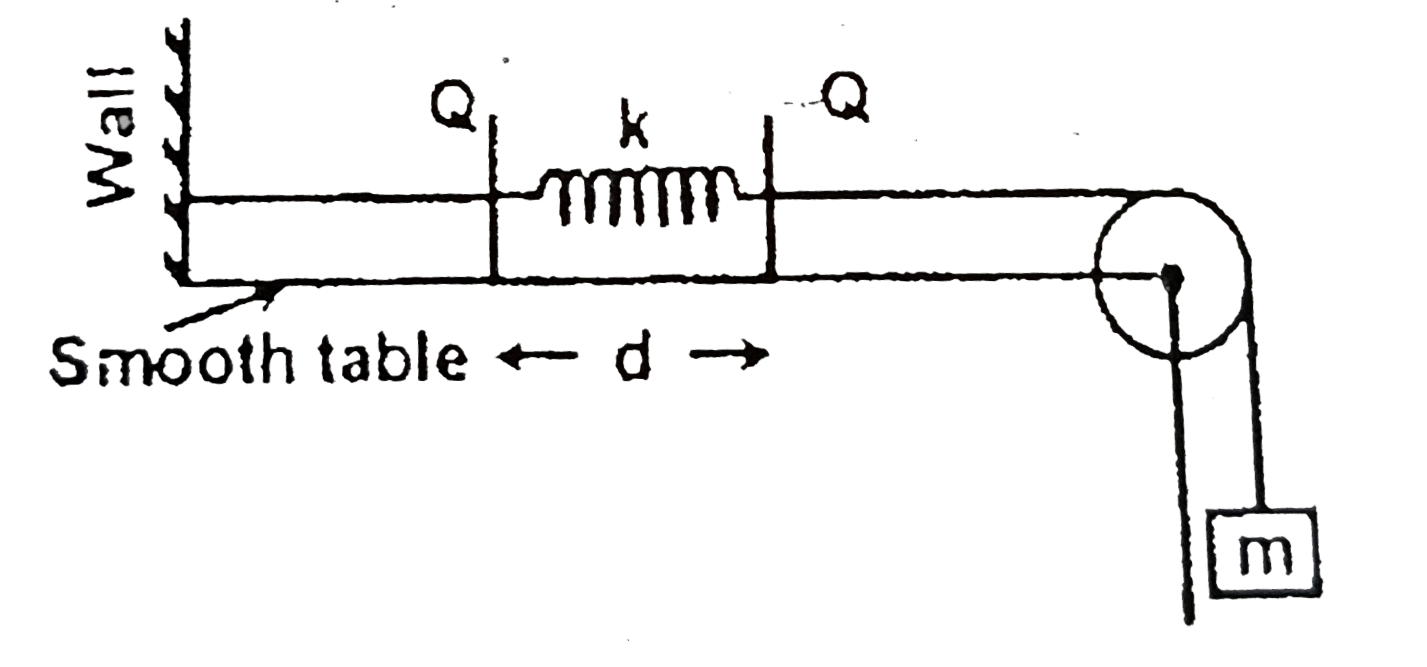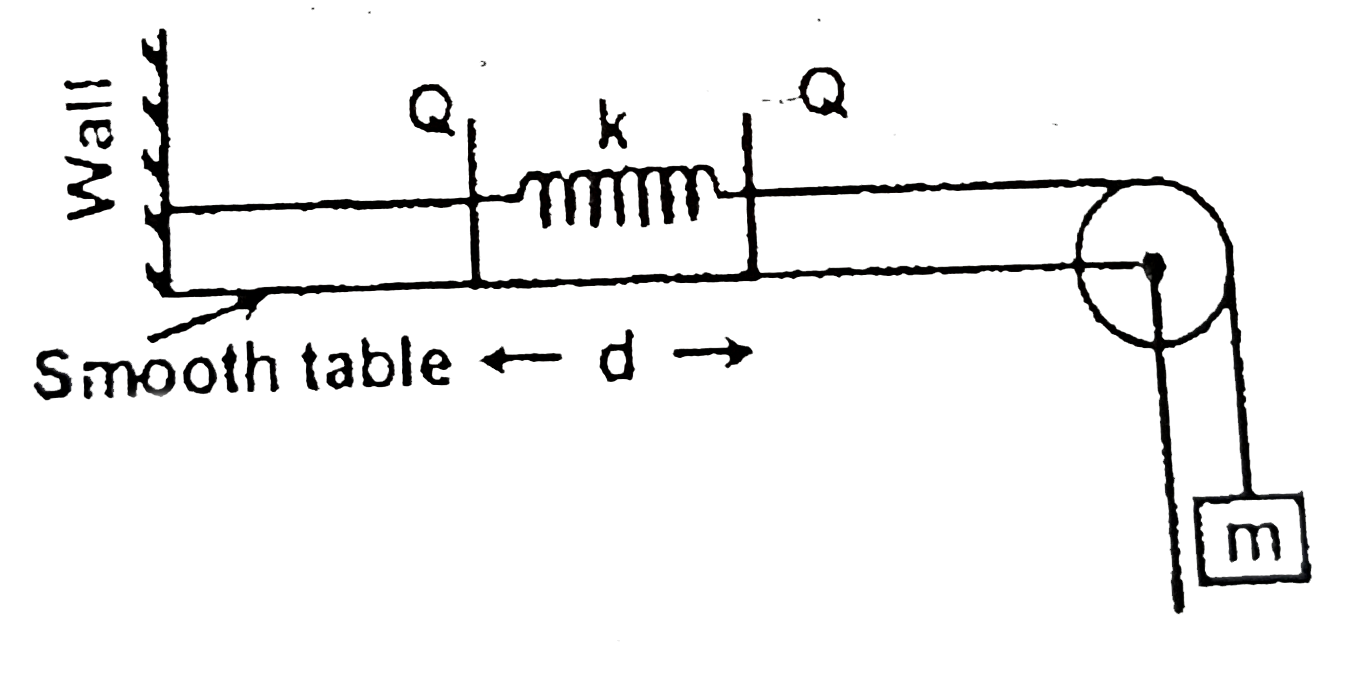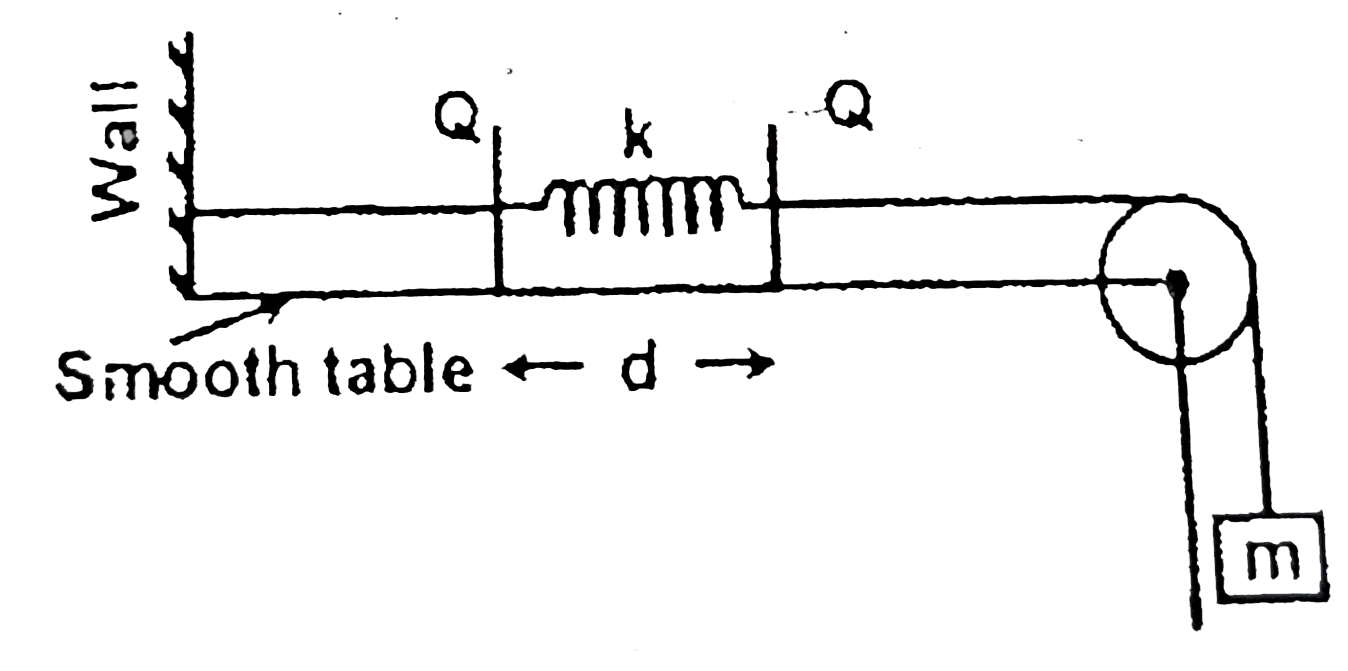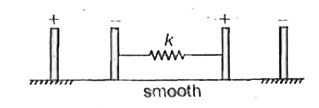The plates each of area A of a parallel plate caoacitor are given charges Q and −Q. The plates are joined by a non-conducting spring of force constant k. The natural length of the spring is d, the inital separation between the plates. The left plate is connected to a vertical wall through a massless non-conducting rope and the right plate is connected to a block of mass m through similar rope. Assume the pulley to be massless, neglect dielectric effect of the spring and Q2<2mAε0g
If T be the time period of oscillation, then

T>2π√mk
T<2π√mk
T=2π√mk
T will depend on Q.
mg is balanced by the electrostatic force.
Topper's Solved these Questions
- GMP ASSESMENTBOOK - FIITJEECHAPTER - GMP ASSESMENTEXERCISE - Numerical Based
61 Videos
- GMP ASSESMENTBOOK - FIITJEECHAPTER - GMP ASSESMENTEXERCISE - Multiple Question
58 Videos
- GENERAL PHYSICSBOOK - FIITJEECHAPTER - GENERAL PHYSICSEXERCISE - MATRIX MATCH TYPE
3 Videos
- GRAVITATIONBOOK - FIITJEECHAPTER - GRAVITATIONEXERCISE - Numerical based Question
2 Videos
Similar Questions
The plates each of area A of a parallel plate caoacitor are given charges Q and −Q. The plates are joined by a non-conducting spring of force constant k. The natural length of the spring is d, the inital separation between the plates. The left plate is connected to a vertical wall through a massless non-conducting rope and the right plate is connected to a block of mass m through similar rope. Assume the pulley to be massless, neglect dielectric effect of the spring and Q2<2mAε0g.
If the block is released from rest, the maximum elongation of the string is

View SolutionThe plates each of area A of a parallel plate caoacitor are given charges Q and −Q. The plates are joined by a non-conducting spring of force constant k. The natural length of the spring is d, the inital separation between the plates. The left plate is connected to a vertical wall through a massless non-conducting rope and the right plate is connected to a block of mass m through similar rope. Assume the pulley to be massless, neglect dielectric effect of the spring and Q2<2mAε0g
If Q2=2mAε0g, the elongation of the string is

View Solution
Knowledge Check
The plates each of area A of a parallel plate caoacitor are given charges Q and −Q. The plates are joined by a non-conducting spring of force constant k. The natural length of the spring is d, the inital separation between the plates. The left plate is connected to a vertical wall through a massless non-conducting rope and the right plate is connected to a block of mass m through similar rope. Assume the pulley to be massless, neglect dielectric effect of the spring and Q2<2mAε0g.
If the block is released from rest, the maximum elongation of the string is
 A2k(mg−Q2Aε0)B2k(mg−2Q2Aε0)C2k(mg−Q22Aε0)DNone of these
A2k(mg−Q2Aε0)B2k(mg−2Q2Aε0)C2k(mg−Q22Aε0)DNone of theseThe plates each of area A of a parallel plate caoacitor are given charges Q and −Q. The plates are joined by a non-conducting spring of force constant k. The natural length of the spring is d, the inital separation between the plates. The left plate is connected to a vertical wall through a massless non-conducting rope and the right plate is connected to a block of mass m through similar rope. Assume the pulley to be massless, neglect dielectric effect of the spring and Q2<2mAε0g
If Q2=2mAε0g, the elongation of the string is
 AzeroB2k(mg−Q2Aε0)C2k(2mg−Q2Aε0)DNone of these
AzeroB2k(mg−Q2Aε0)C2k(2mg−Q2Aε0)DNone of theseTwo charged capacitors have their outer plates fixed and inner plates connected by a spring of force constant 'K'. The charge on each capacitor is q. find the extension in the spring at equilibrium
 Aq22Aε0KBq24Aε0KCq2Aε0KDzero
Aq22Aε0KBq24Aε0KCq2Aε0KDzero
Each plate of a parallel plate capacitor has a charge q on it. The capacitor is now connected to a battery. Now,
View SolutionEach plate of a parallel plate capacitor has a charge q on it. The capacitor is now connected to a battery. Now,
View SolutionTwo charged capacitors have their outer plates fixed and inner plates connected by a spring of force constant 'K'. The charge on each capacitor is q. find the extension in the spring at equilibrium

View SolutionTwo large conducting plates of a parallel plate capacitor are given charges Q and 3Q respectively. If the electric field in the region between the plates is E0 , then the force of interaction between the plates is

View SolutionTwo large conducting plates of a parallel plate capacitor are given charges Q and 3Q respectively. If the electric field in the region between the plates is E0 , then the force of interaction between the plates is

View Solution
